The stunning world of floral wonders is nature’s artistic masterpiece, featuring magnificent scents, exquisite shapes, and vibrant colors. These tantalizing treasures include many beautiful types of flowers, but some of the most glorious are those that start with the letter T. From the delicate elegance of tulips to the mesmerizing patterns of the tiger lily, each flower on this list exudes its own unique charm. Come along on a botanical journey as we unveil some gorgeous flowers that start with T!
1. Tiger Flower (Tigridia pavonia)
The tiger flower is an extraordinary perennial native to Central America and Mexico. Its exotic blossoms are large, with vibrantly colored petals and uniquely spotted centers. Tiger flowers are typically 3 to 6 inches in diameter and come in many different colors, including purple, yellow, red, orange, white, and pink. They also have a unique two-tone appearance, with contrasting colors and patterns on the larger and smaller petals of each flower. The center of a tiger flower also has a cluster of bright yellow stamens, adding to its colorful and dazzling appeal.
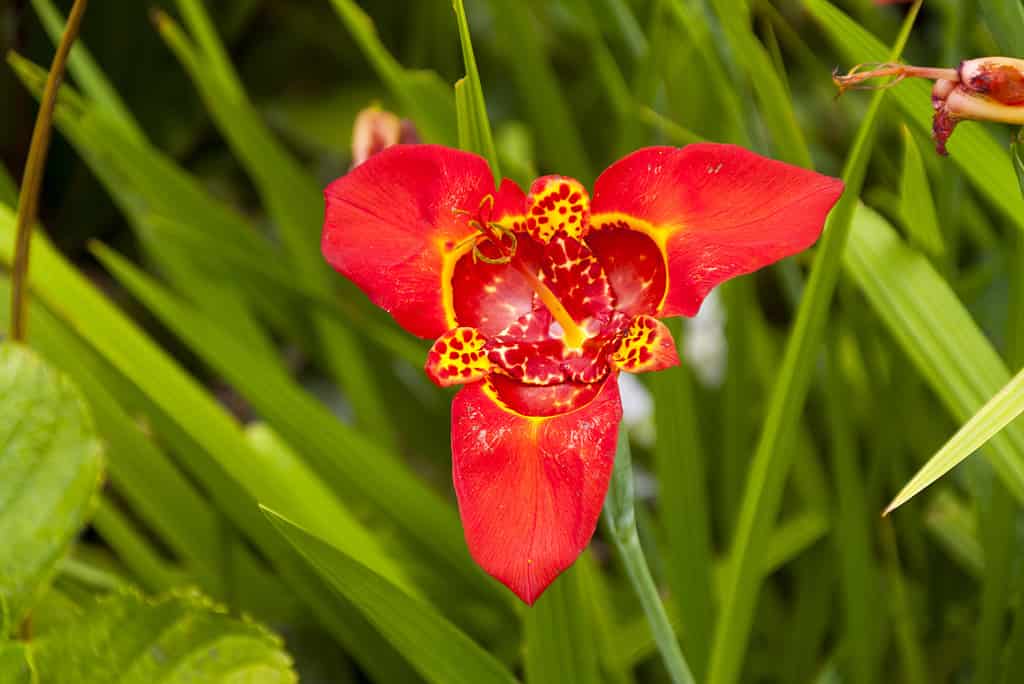
Roasted tiger flower bulbs are edible and have a chestnut-like flavor.
©Wirestock/ via Getty Images
2. Tiger Lily (Lilium lancifolium)
Adorned with tiny black spots, the bright orange tiger lily is reminiscent of a stunning wild tiger. Tiger lilies are native to Korea, Japan, China, and the Russian far east. They are tall and stately flowers that bloom in the spring and are popular as ornamental plants. Tiger lilies are also unique because they reproduce using two different methods.
First, tiger lilies produce bulblets, which are tiny little growths in the leaf axles (where the leaves meet the stem). These bulblets are like tiny seed pods and contain all the genetic material they need to grow into a brand-new second plant! Second, each tiger lily has additional bulbs with attached bulblets growing underground that you can also separate and replant.
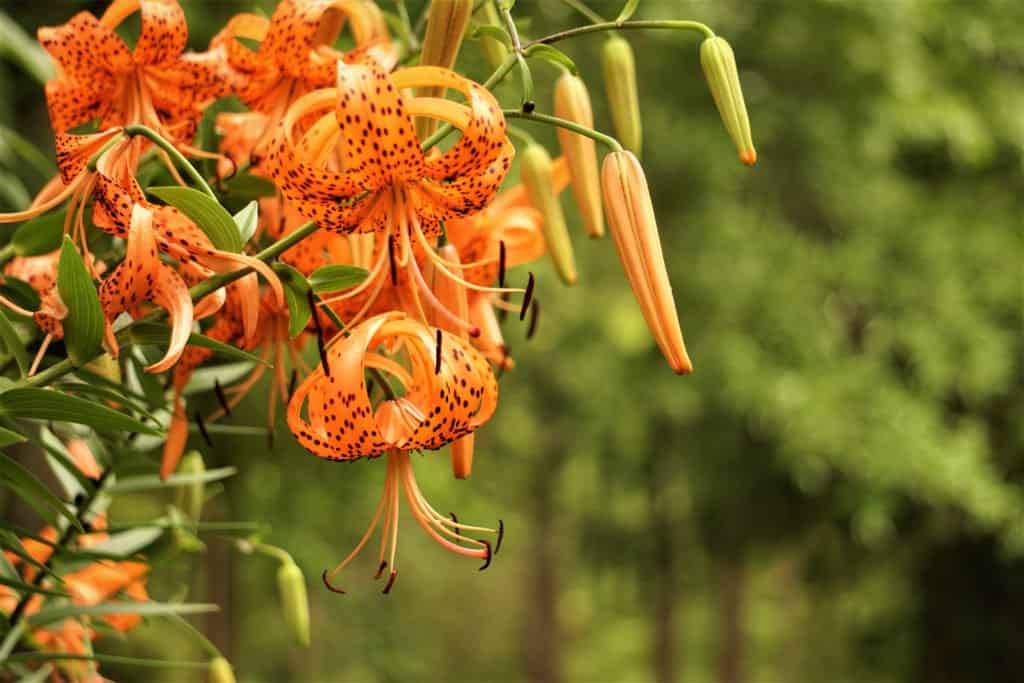
Tiger lily flowers are toxic to cats.
©Ancha Chiangmai/Shutterstock.com
3. Trillium (Trillium)
A genus of woodland flowers, trillium plants go by many names, such as birthroot, wood lily, triflower, wakerobin, and toadshade. These gorgeous flowers that start with T have beautiful blossoms with three distinct petals arranged in a spiral-type design. Their flowers are purple, yellow, white, or pink, with three contrasting sepals framing each blossom. Trillium flowers are native to Asia and North America. Unfortunately, some species are endangered or threatened. In many areas, it is illegal to pick any of these flowers.

The white trillium is the official emblem of the Province of Ontario and the State Wildflower of Ohio.
©iStock.com/SHSPhotography
4. Throatwort (Trachelium)
Native to Africa, Asia, and Europe, throatwort flowers are small and delicate, blooming in the summer months. Their bell-shaped blossoms come in many colors like purple, white, pink, and blue. The tiny flowers bloom in lace-like clusters atop the tall stems of the plant. Depending on the species, throatwort can be either an annual or a perennial. Throatwort flowers get their name from the plant’s use in folk medicine, as some believed they helped with throat problems.

“
Trachelium” comes from a Greek word meaning “neck,” referencing the belief that it cures sore throats.
©Furiarossa/Shutterstock.com
5. Tulip (Tulipa)
One of the most well-known flowers that starts with T is the tulip. Although many people associate tulips with Holland and the Netherlands, these colorful flowers are actually native to Central Asia. Tulips have been cultivated since the tenth century, but it wasn‘t until the seventeenth century that they really took off during “tulip mania”. Many artists in the northern Baroque and Dutch Golden Age included tulips in their paintings, including the famous artist, Rembrandt. There are around 75 different species of tulips, and they come in a plethora of different colors. Some tulips even have variegated patterns. Tulips bloom in the spring, emerging from their underground bulbs after a long dormant period.
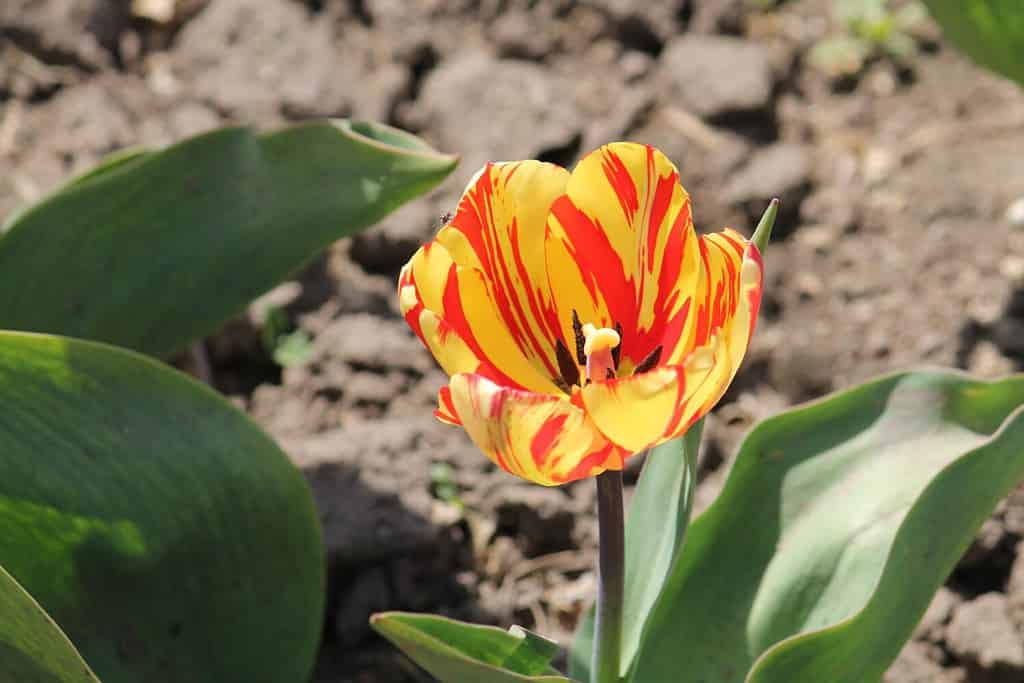
Cultivated tulips with a variegated pattern result from breeding with the tulip-breaking virus (TBV).
©Kazakov Maksim/Shutterstock.com
6. Transvaal Daisy (Gerbera jamesonii)
The Transvaal daisy hails from Southeastern Africa and is also known as the Barberton daisy and the Rooigousblom. It is a type of gerbera daisy, with large, show-stopping flowers that can have single, double, or even semi-double blooms. Transvaal daisies are typically a fiery combination of orange and red, but occasionally some can also be pink, yellow, white, or orange. The blossoms can grow more than 4 inches in diameter and bloom atop plants growing 18 inches off the ground.
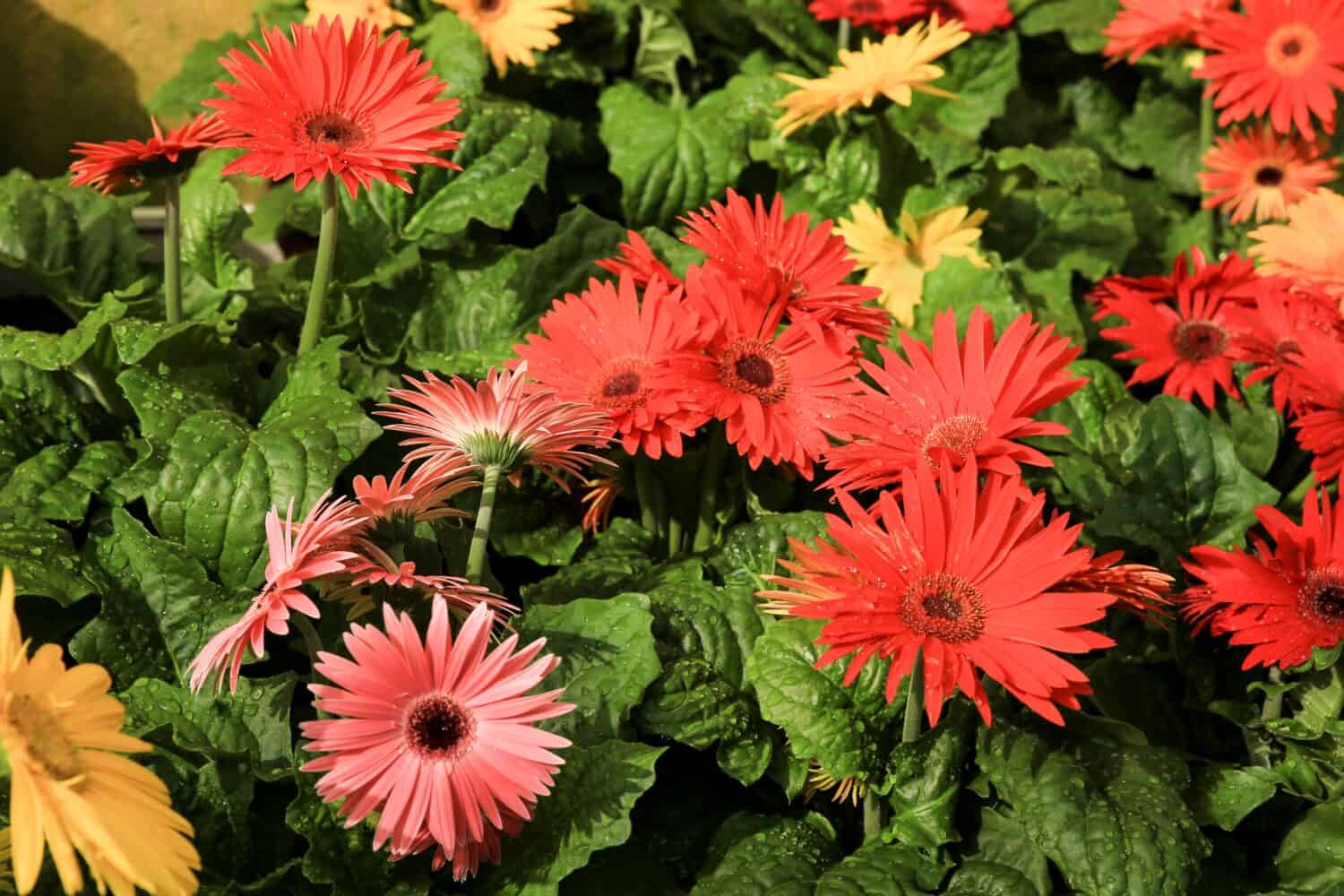
Transvaal daisy blossoms can grow more than 4 inches in diameter.
©Sonia Bonet/Shutterstock.com
7. Tuberous Begonia (Begonia tuberhybrida)
These popular begonia flowers bloom on both upright and trailing plants, with beautiful green, purple, gold, or burgundy heart-shaped or lobed leaves. Tuberous begonia flowers are large, with ruffled, single, or double petals that come in stunning shades of red, white, orange, yellow, and pink. These showy flowers that start with T grow up to 6 inches wide and bloom from summer to fall. They are native to tropical regions of Southern Africa and South America and store food and energy in their tuberous roots.
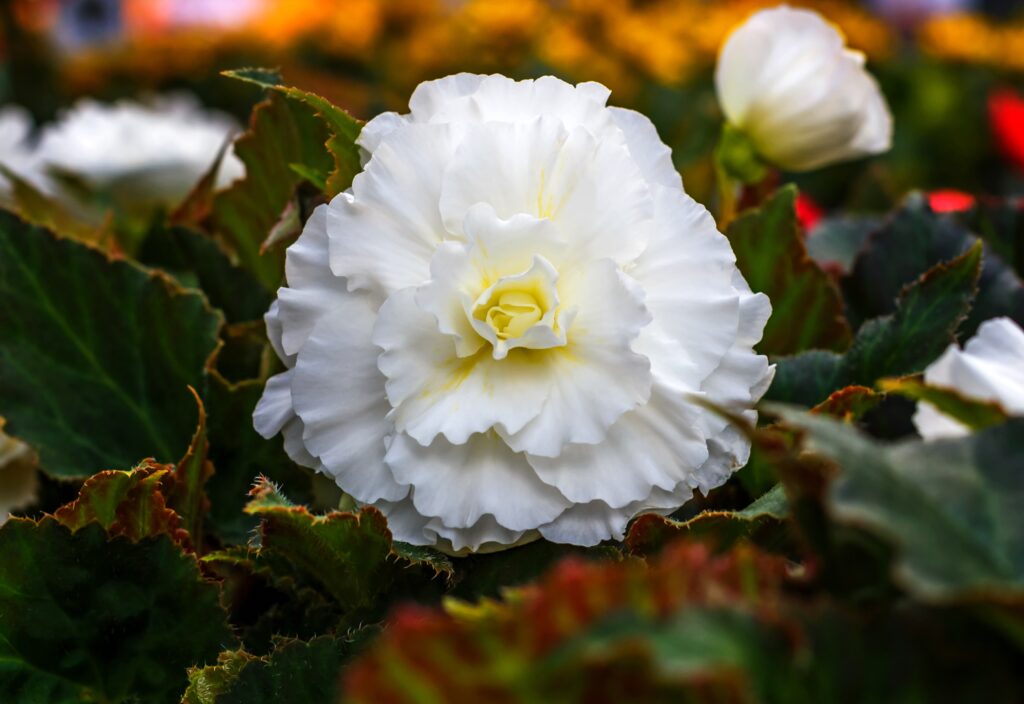
Tuberous begonias are relatively easy to care for. They can be grown indoors or outdoors.
©Nnattalli/Shutterstock.com
7. Turtlehead (Chelone obliqua)
The turtlehead is endemic to the United States, but it is not a very common flower. It is a perennial wildflower in the southeastern and midwestern states, where it grows 2 to 3 feet tall and 1 to 2 feet wide. The plant gets its name from the snapdragon-like flowers it produces, which somewhat resemble the head of a turtle. These unique blossoms are typically purple, red, or pink, and bloom from late summer to fall. Turtlehead flowers are tubular, growing 1 to 2 inches in diameter with a hood-like upper lip and a three-lobed lower lip.

The rose turtlehead can grow up to 2 to 3 feet tall.
©imageBROKER.com/Shutterstock.com
9. Tea Rose (Rosa odorata)
Native to China, tea roses are a popular choice for gardeners all across the world. These beautiful flowers are well known for their fragrant blossoms. Tea roses stay fresh for a long time and showcase a lovely range of colors. From soft shades of white and pink to radiant yellow or apricot tones, each flower has its own unique charm. The petals of a tea rose flower unfurl in a mesmerizing spiral, with the edges rolling back gracefully to form a distinctly pointed tip.
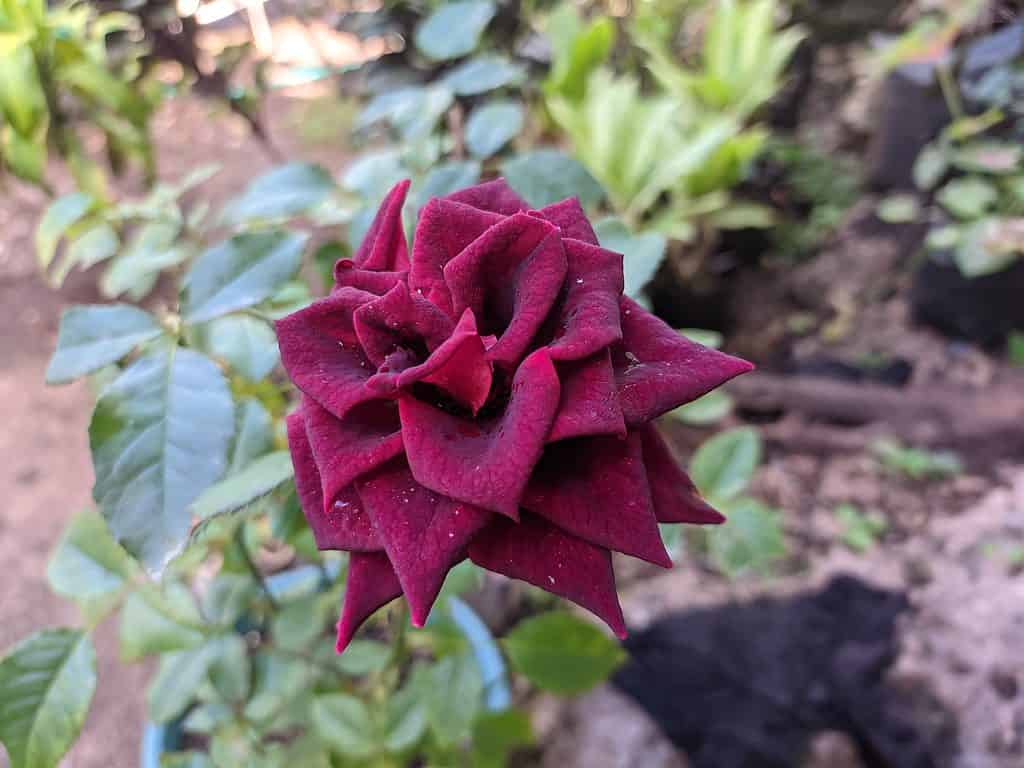
The Mister Lincoln hybrid tea rose is highly praised among rose enthusiasts.
©Rita95/Shutterstock.com
10. Toadflax (Linaria vulgaris)
Toadflax is a common wildflower in North America and Europe, although it was originally native to Eurasia. These gorgeous flowers that start with T go by a wide variety of different names, including toadflax, wild snapdragon, and butter-and-eggs. Toadflax flowers are reminiscent of snapdragons and often showcase a sunny yellow or creamy hue with a tiny burst of orange. These vibrant flowers instantly brighten up any meadow or garden!
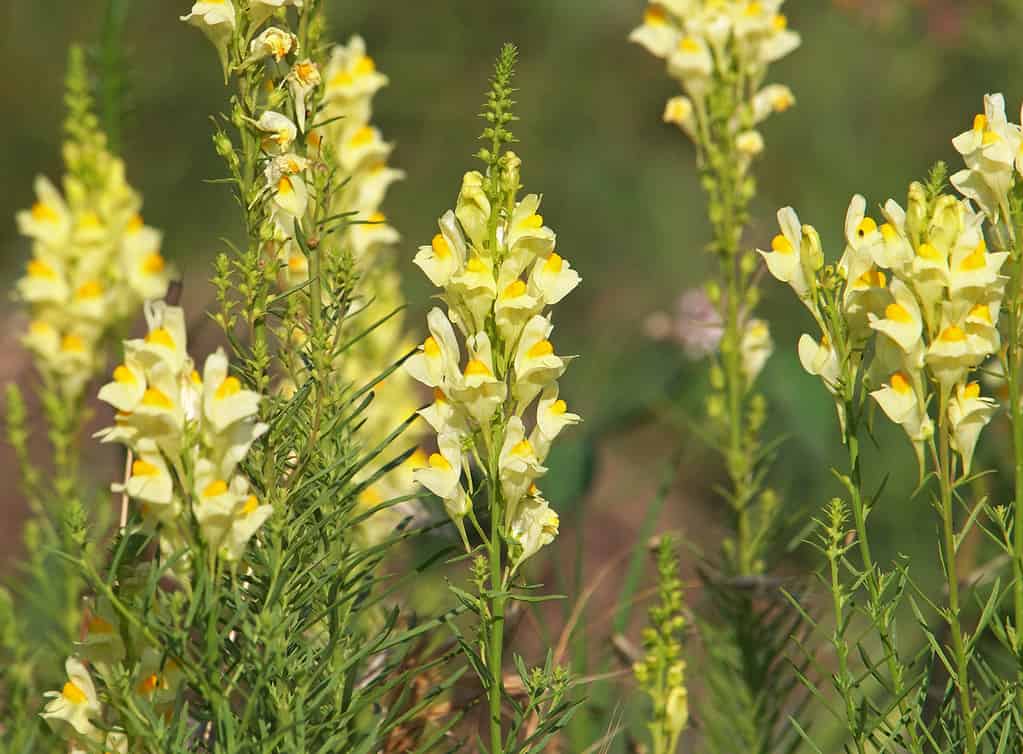
Toadflax spreads through creeping rhizomes as well as by scattering seeds.
©iStock.com/emilio100
11. Toyon (Heteromeles arbutifolia)
This beautiful shrub is native to California and has lovely little white flowers that bloom in the spring and summer. Toyon flowers smell faintly like hawthorn or thornapple and attract insects and butterflies. They bloom in beautiful clusters on the end of the shrub’s branches, and each is about 0.5 inches in diameter with five small petals.
In the fall, the flowers are replaced with tiny bright red berries that are about 0.25 inches in diameter. The berries are edible and provide a tasty treat for small animals and birds. Humans can eat them too, but they need to be cooked first to remove the cyanogenic glycosides (these can turn into hydrocyanic acid). Toyon berries have a unique and slightly tart flavor, and many people use them to make treats and decorations during the winter holidays.
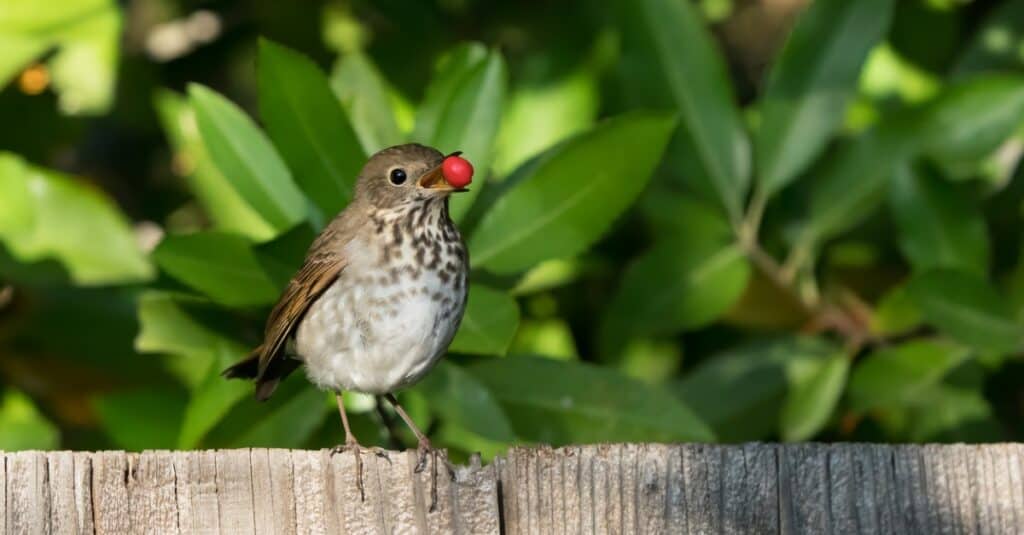
Although they have a sour taste, many birds and small animals eat toyon berries.
©iStock.com/Wendy/Jeff Sparks/Torquemada
12. Treasure Flower (Gazania rigens)
These gorgeous flowers that start with T are aptly named, as their bright colors and spirited blossoms add a unique treasure-like quality to any garden. Also called gazanias and African daisies, treasure flowers close up at night, only sharing their vibrant colors with the world when the sun is shining.
Treasure flowers are native to South Africa where they mainly grow in coastal areas. They bloom in spring and summer, with blossoms that are about 2 to 5 inches wide. Treasure flowers have a single layer of long, slender petals that encircle a yellow disk in the center of the flower and are usually red, orange, or yellow, but some can also be pink or white.
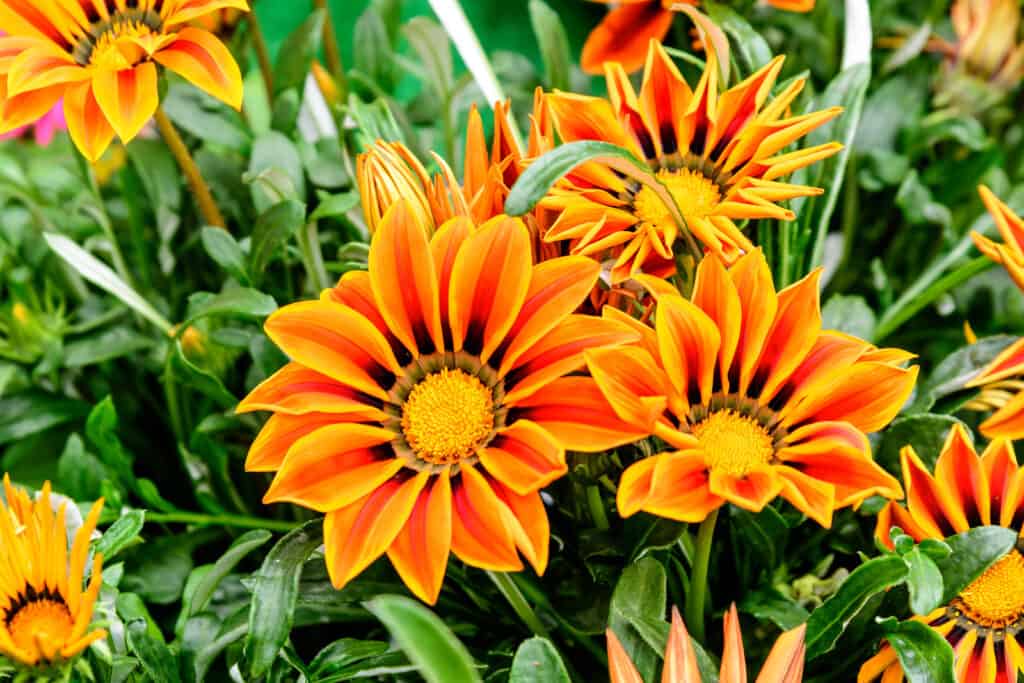
The genus “Gazania” comes from a Latin word that means “treasure”.
©iStock.com/Cristina Ionescu
13. Twinspur (Diascia barberae)
Native to South Africa and Lesotho, twinspur flowers bloom from summer to fall. These whimsical flowers have delicate, fused petals that create a slender tube. Within this intricate structure, there are two elongated spurs that gracefully extend from the back of the flower and serve as an invitation to pollinators. Filled with sweet nectar, they act as alluring beacons for bees and butterflies, making twinspur flowers a great addition to your garden if you’re wanting to attract pollinators!

Twinspur flowers bloom in clusters of pink, red, white, orange, or yellow.
©ChWeiss/Shutterstock.com
14. Tartarian Aster (Crinitaria tatarica or Aster tataricus)
With light purple or lavender-blue petals, Tartarian asters are cheerful flowers that bloom in late summer and fall. Their flowers are about 1 inch wide, with petals encircling golden-yellow centers like a daisy. Tartarian asters are tall flowers, growing in large clusters 3 to 6 feet tall and 2 to 3 feet wide. They are native to the Tartar region of Russia, which is also where they get their name. They are also sometimes called “Siberian asters” as well. The word “aster” comes from Latin, meaning “star” and refers to the flowers’ star-burst blossoms.

Tartarian asters are excellent for attracting pollinators like butterflies, and they are also deer-resistant.
©Liz Albro Photography/Shutterstock.com
15. Tennessee Coneflower (Echinacea tennesseensis)
The genus of the Tennessee coneflower, “Echinacea”, comes from a Greek word that means “hedgehog” or “sea-urchin”. This refers to the unique and spiny cone or disc at the center of these flowers. Tennessee coneflowers have stunning rose-colored petals that are long and slender, which harmonize beautifully with the flower’s coppery brown central cone and tiny yellow stamens. They are sweet-smelling flowers that bloom from June until August and grow 2 to 3 feet tall. Tennessee coneflowers were previously listed as an endangered species. Although they are recovering, they are still threatened by habitat loss, invasive species, and habitat fragmentation.
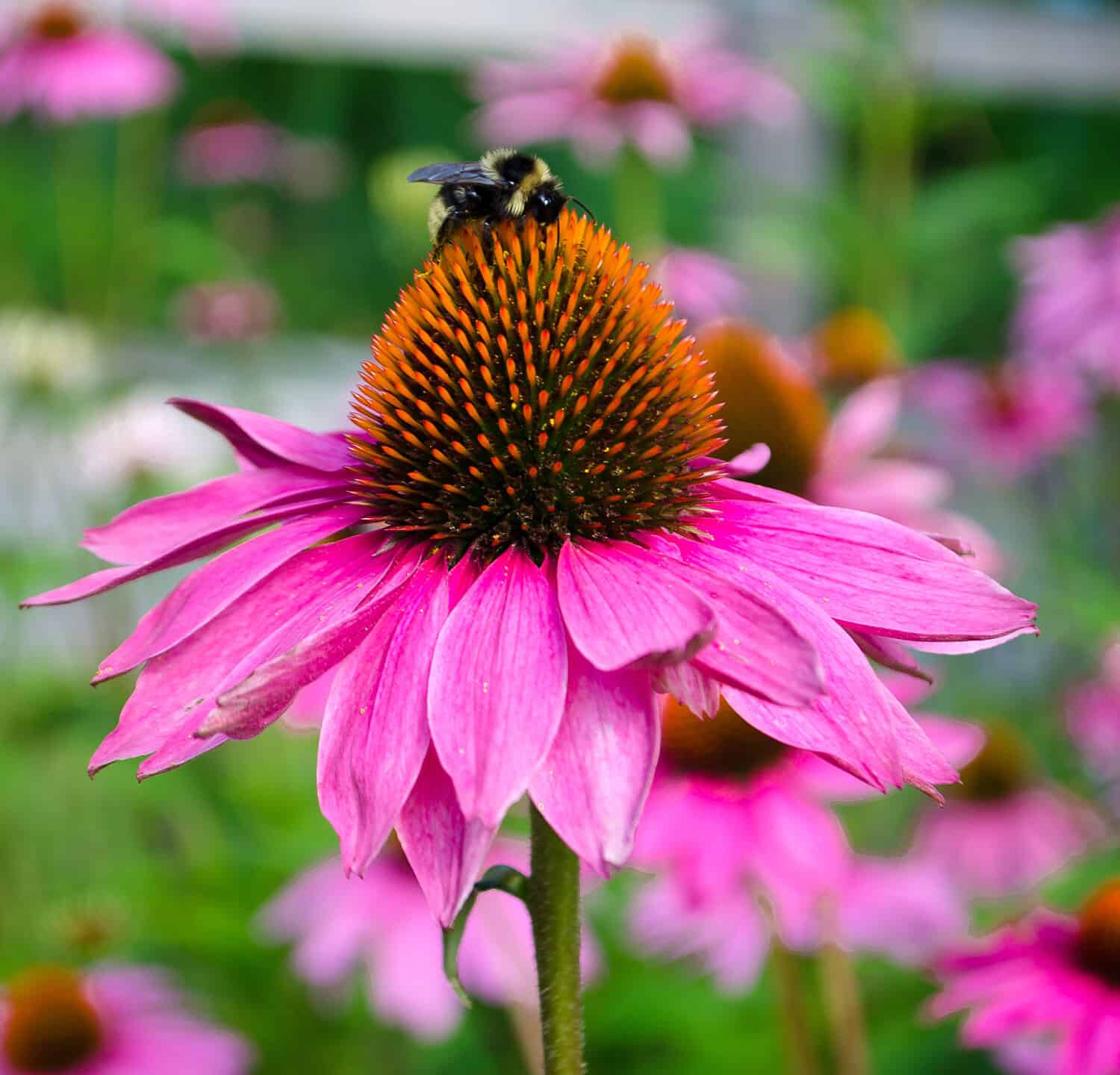
Tennessee coneflowers are herbaceous perennials.
©Emily Goodwin/Shutterstock.com
16. Texas Mountain Laurel (Sophora secundiflora)
Growing either as a shrub or a small tree, Texas mountain laurel flowers are absolutely breathtaking. Their vibrant purple or purple-blue flowers suspend from the plant in abundant, drooping clusters, reminiscent of elegant wisteria blooms. Texas mountain laurels are enchanting flowers that emanate a tantalizing fragrance — many people say that they smell like fizzy grape soda or grape bubble gum! Texas mountain laurels are evergreen shrubs that grow slowly but can reach up to 15 to 25 feet tall and 8 to 10 feet wide. After the beautiful flowers die off, the plants produce 8-inch-long hanging seed pods with ruby-red seeds.

Some people use the bright red seeds of the Texas mountain laurel to make necklaces.
©Harry Thomas Flower/Shutterstock.com
17. Thimbleweed (Anemone virginiana)
Growing atop delicate, long stems, thimbleweed flowers are about 1 inch wide with white or greenish-white petals surrounding the center like a tiny little star. The center of the flower is a slightly elongated mound of yellow-to-greenish stamens, making it look like a tiny thimble.
Tumbleweed plants can grow up to 3 feet tall and can tolerate deer, drought, and even deep shade, making them a versatile choice for various gardening conditions. However, it’s important to note that you should handle thimbleweed flowers with care. They have toxic properties and ingestion or contact with fresh sap can cause inflammation, blistering, irritation of the mouth, vomiting, and diarrhea.
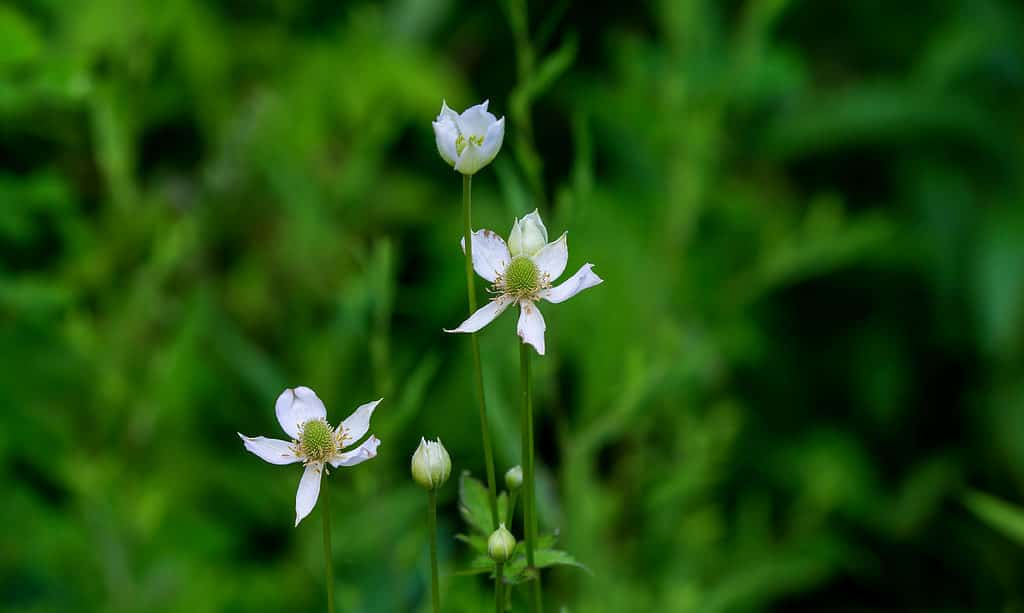
Also known as tall thimbleweed or tall anemone, thimbleweed flowers grow best in woodland gardens.
©iStock.com/Karel Bock
18. Threadleaf Coreopsis (Coreopsis verticillata)
The daisy-like yellow flowers of the threadleaf coreopsis brighten any garden they happen to grow in. A member of the daisy family, threadleaf coreopsis plants grow in dense bushy clumps that are 2 to 3 feet tall and wide. They are native to North America but mostly live in the eastern regions of the United States. Their flowers grow atop tiny, wiry stems and can be up to 2 inches in diameter with silky-soft yellow petals and small golden-yellow centers. They have numerous delicate thread-like spiny leaves arranged in a spiral around the stem.
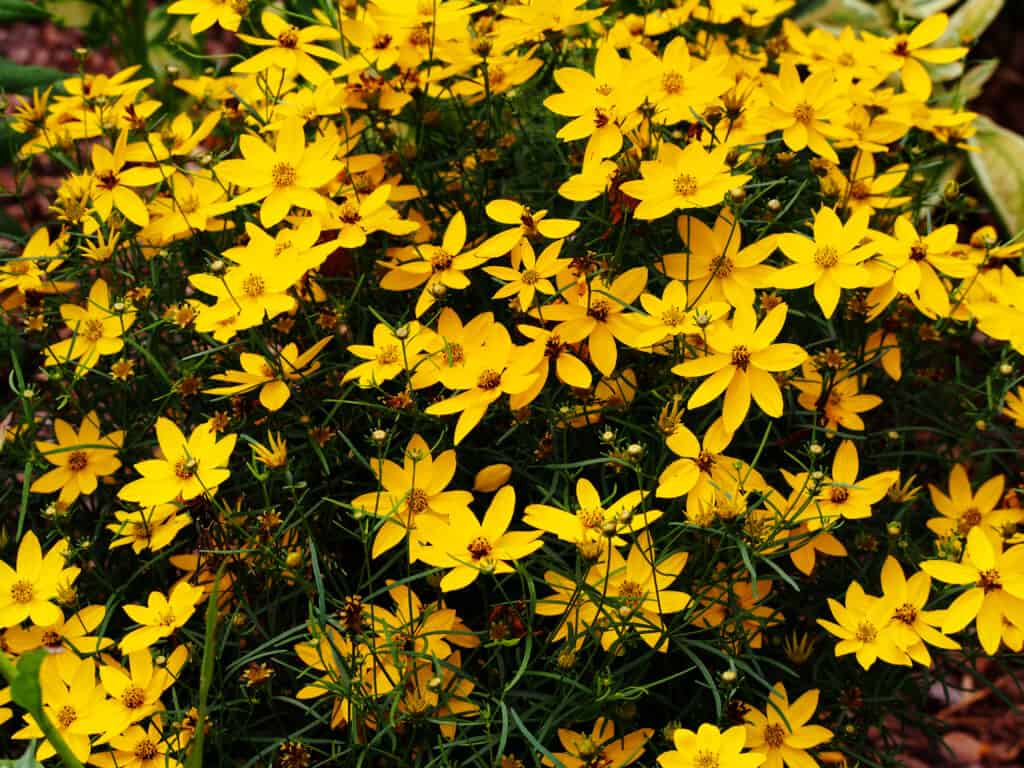
Threadleaf coreopsis flowers are also called whorled coreopsis, tickseed, and threadleaf tickseed.
©iStock.com/Gratysanna
19. Thyme (Thymus vulgaris)
You are probably more familiar with thyme as an herb for cooking, but these useful plants also produce some very charming flowers! With a woody base and perennial nature, thyme is a small and delicate-looking plant that only grows up to 6 inches tall. Its leaves are a subtle shade of gray green, with edges that gently curl under. During the summer, clusters of petite flowers decorate the ends of the plant’s stems, blooming in shades of purple and pink. Although small, these lovely little flowers attract many pollinators like bees, butterflies, and other winged wonders.

is known as common thyme, thyme, German thyme, and garden thyme.
©Emilio100/Shutterstock.com
20. Toad Lily (Tricyrtis)
Native to Asia, toad lilies are perennial wildflowers with small, orchid-like blossoms. However, toad lily flowers are much smaller than orchids, with delicate white or lavender-colored petals and a pop of sunshiny yellow in the center. Their leaves are divided into three lobes like three tiny fingers and are arranged in a fan-like pattern along the stem. Toad lilies are gorgeous flowers that start with T that show off their beautiful blossoms in summer and fall.
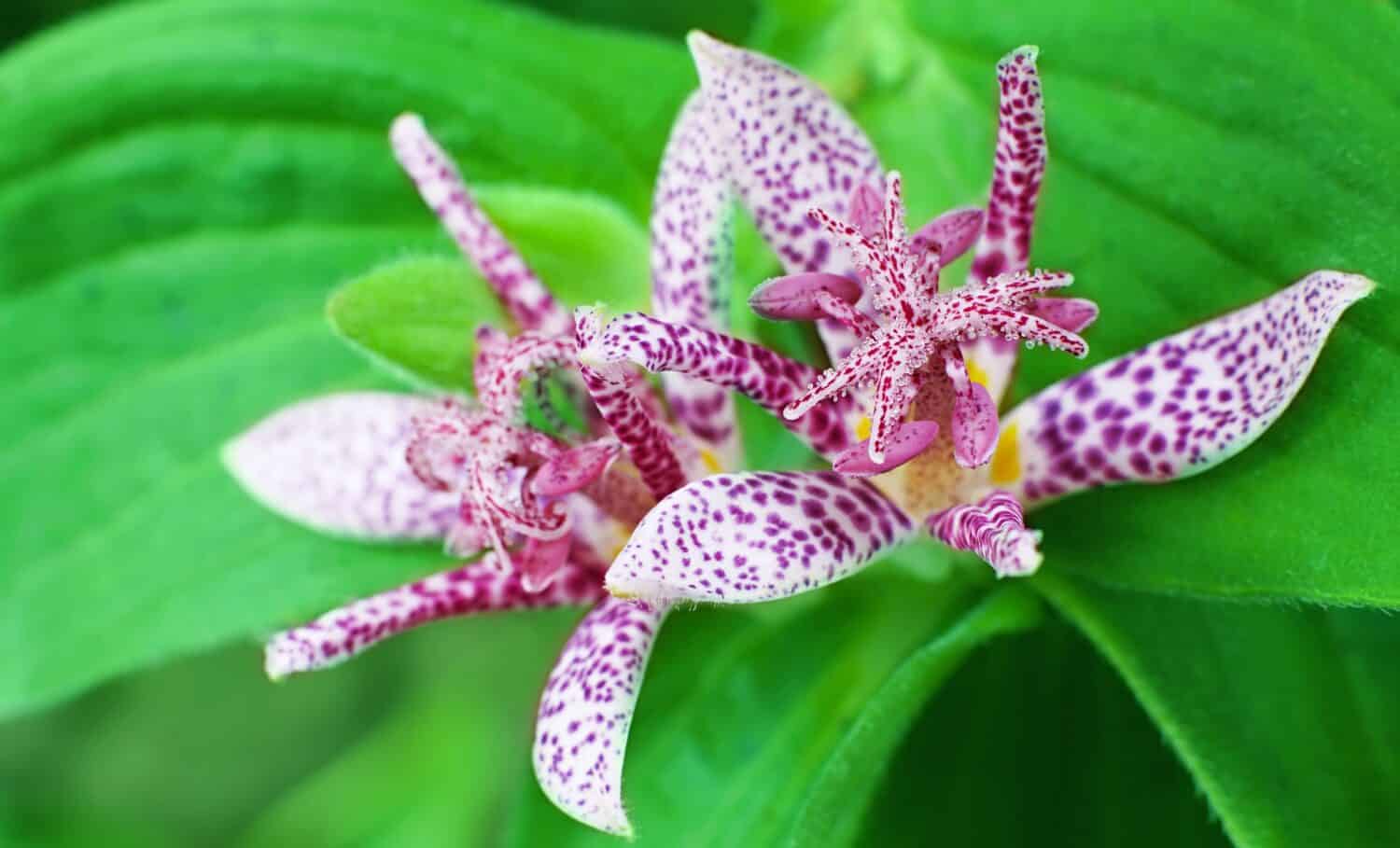
Toad lily flowers are typically hardy plants and can withstand sudden bouts of cold.
©Lancan/Shutterstock.com
Summary of Gorgeous Flowers That Start with T
| Common Name | Scientific Name |
|---|---|
| Tiger Flower | Tigridia pavonia |
| Tiger Lily | Lilium lancifolium |
| Trillium | Trillium |
| Throatwort | Trachelium |
| Tulip | Tulipa |
| Transvaal Daisy | Gerbera jamesonii |
| Tuberous Begonia | Begonia tuberhybrida |
| Turtlehead | Chelone obliqua |
| Tea Rose | Rosa odorata |
| Toadflax | Linaria vulgaris |
| Toyon | Heteromeles arbutifolia |
| Treasure Flower | Gazania rigens |
| Twinspur | Diascia barberae |
| Tartarian Aster | Crinitaria tatarica or Aster tataricus |
| Tennessee Coneflower | Echinacea tennesseensis |
| Texas Mountain Laurel | Sophora secundiflora |
| Thimbleweed | Anemone virginiana |
| Threadleaf Coreopsis | Coreopsis verticillata |
| Thyme | Thymus vulgaris |
| Toad Lily | Tricyrtis |
Thank you for reading! Have some feedback for us? Contact the AZ Animals editorial team.








